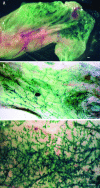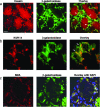Interaction with the mammary microenvironment redirects spermatogenic cell fate in vivo
- PMID: 17360445
- PMCID: PMC1820676
- DOI: 10.1073/pnas.0611637104
Interaction with the mammary microenvironment redirects spermatogenic cell fate in vivo
Abstract
Previously, we characterized a parity-induced mammary epithelial cell population that possessed the properties of pluripotency and self-renewal upon transplantation. These cells were lineally marked by the expression of beta-galactosidase (LacZ) as a result of mammary-specific activation of a reporter gene through Cre-lox recombination during pregnancy. We used this experimental model to determine whether testicular cells would alter their cell fate upon interaction with the mammary gland microenvironment during pregnancy, lactation, and involution. Adult testicular cells, isolated from seminiferous tubules, were mixed with limiting dilutions of dispersed mammary epithelial cells and injected into epithelium-divested mammary fat pads. The host mice were bred 6-8 weeks later and examined 20-30 days postinvolution. This approach allowed for the growth of mammary tissue from the injected cells and transient activation of the whey acidic protein promoter-Cre gene during pregnancy and lactation, leading to Cre-lox recombination and constitutive expression of LacZ from its promoter. Here we show that cells from adult seminiferous tubules interact with mammary epithelial cells during regeneration of the gland. They adopt mammary epithelial progenitor cell properties, including self-renewal and the production of cell progeny, which differentiate into functional mammary epithelial cells. Our results provide evidence for the ascendancy of the tissue microenvironment over the intrinsic nature of cells from an alternative adult tissue.
Conflict of interest statement
The authors declare no conflict of interest.
Figures




References
MeSH terms
LinkOut - more resources
Full Text Sources

